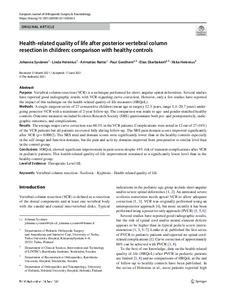Health-related quality of life after posterior vertebral column resection in children: comparison with healthy controls
Raitio Arimatias; Diarbakerli Elias; Helenius Linda; Syvänen Johanna; Gerdhem Paul; Helenius Ilkka
https://urn.fi/URN:NBN:fi-fe2021100750350
Tiivistelmä
Purpose
Vertebral column resection (VCR) is a technique performed for short, angular spinal deformities. Several studies have reported good radiographic results with VCR regarding curve correction. However, only a few studies have reported the impact of this technique on the health-related quality-of-life measures (HRQoL).
Methods
A single surgeon series of 27 consecutive children (mean age at surgery 12.3 years, range 1.1–20.7 years) undergoing posterior VCR with a minimum of 2-year follow-up. The comparison was made to age- and gender-matched healthy controls. Outcome measures included Scoliosis Research Society (SRS) questionnaire both pre- and postoperatively, radiographic outcomes, and complications.
Results
The average major curve correction was 60.3% in the VCR patients. Complications were noted in 12 out of 27 (44%) of the VCR patients but all patients recovered fully during follow-up. The SRS pain domain scores improved significantly after VCR (p = 0.0002). The SRS total and domain scores were significantly lower than in the healthy controls especially in the self-image and function domains, but the pain and activity domains improved from preoperative to similar level than in the control group.
Conclusions
HRQoL showed significant improvement in pain scores despite 44% risk of transient complications after VCR in pediatric patients. This health-related quality-of-life improvement remained at a significantly lower level than in the healthy control group.
Kokoelmat
- Rinnakkaistallenteet [27094]
